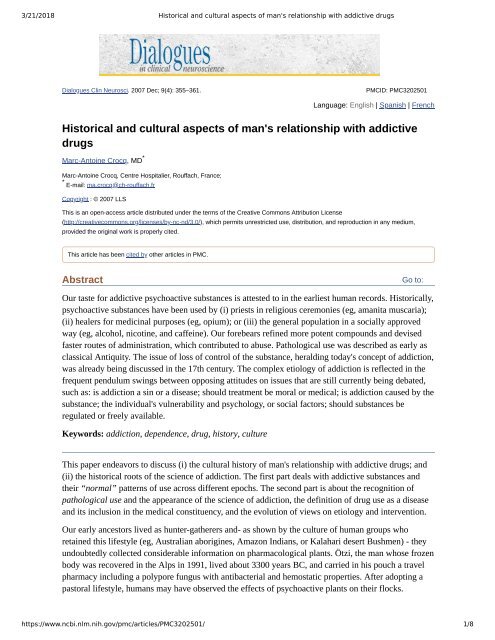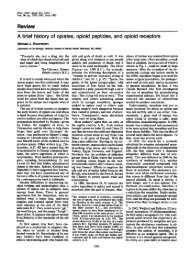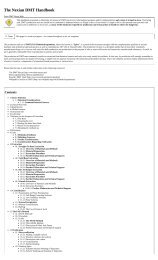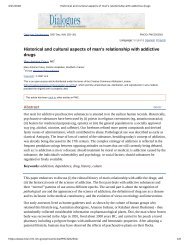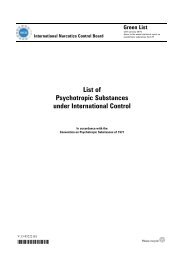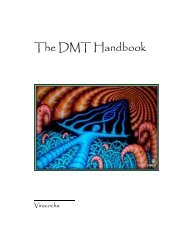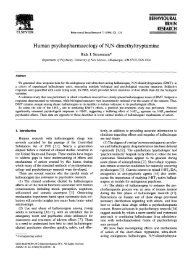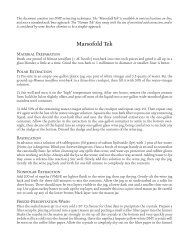Historical and cultural aspects of man's relationship with addictive drugs
Historical and cultural aspects of man's relationship with addictive drugs
Historical and cultural aspects of man's relationship with addictive drugs
Create successful ePaper yourself
Turn your PDF publications into a flip-book with our unique Google optimized e-Paper software.
3/21/2018 <strong>Historical</strong> <strong>and</strong> <strong>cultural</strong> <strong>aspects</strong> <strong>of</strong> <strong>man's</strong> <strong>relationship</strong> <strong>with</strong> <strong>addictive</strong> <strong>drugs</strong><br />
Dialogues Clin Neurosci. 2007 Dec; 9(4): 355–361.<br />
PMCID: PMC3202501<br />
Language: English | Spanish | French<br />
<strong>Historical</strong> <strong>and</strong> <strong>cultural</strong> <strong>aspects</strong> <strong>of</strong> <strong>man's</strong> <strong>relationship</strong> <strong>with</strong> <strong>addictive</strong><br />
<strong>drugs</strong><br />
*<br />
Marc-Antoine Crocq, MD<br />
Marc-Antoine Crocq, Centre Hospitalier, Rouffach, France;<br />
*<br />
E-mail: ma.crocq@ch-rouffach.fr<br />
Copyright : © 2007 LLS<br />
This is an open-access article distributed under the terms <strong>of</strong> the Creative Commons Attribution License<br />
(http://creativecommons.org/licenses/by-nc-nd/3.0/), which permits unrestricted use, distribution, <strong>and</strong> reproduction in any medium,<br />
provided the original work is properly cited.<br />
This article has been cited by other articles in PMC.<br />
Abstract<br />
Go to:<br />
Our taste for <strong>addictive</strong> psychoactive substances is attested to in the earliest human records. <strong>Historical</strong>ly,<br />
psychoactive substances have been used by (i) priests in religious ceremonies (eg, amanita muscaria);<br />
(ii) healers for medicinal purposes (eg, opium); or (iii) the general population in a socially approved<br />
way (eg, alcohol, nicotine, <strong>and</strong> caffeine). Our forebears refined more potent compounds <strong>and</strong> devised<br />
faster routes <strong>of</strong> administration, which contributed to abuse. Pathological use was described as early as<br />
classical Antiquity. The issue <strong>of</strong> loss <strong>of</strong> control <strong>of</strong> the substance, heralding today's concept <strong>of</strong> addiction,<br />
was already being discussed in the 17th century. The complex etiology <strong>of</strong> addiction is reflected in the<br />
frequent pendulum swings between opposing attitudes on issues that are still currently being debated,<br />
such as: is addiction a sin or a disease; should treatment be moral or medical; is addiction caused by the<br />
substance; the individual's vulnerability <strong>and</strong> psychology, or social factors; should substances be<br />
regulated or freely available.<br />
Keywords: addiction, dependence, drug, history, culture<br />
This paper endeavors to discuss (i) the <strong>cultural</strong> history <strong>of</strong> <strong>man's</strong> <strong>relationship</strong> <strong>with</strong> <strong>addictive</strong> <strong>drugs</strong>; <strong>and</strong><br />
(ii) the historical roots <strong>of</strong> the science <strong>of</strong> addiction. The first part deals <strong>with</strong> <strong>addictive</strong> substances <strong>and</strong><br />
their “normal” patterns <strong>of</strong> use across different epochs. The second part is about the recognition <strong>of</strong><br />
pathological use <strong>and</strong> the appearance <strong>of</strong> the science <strong>of</strong> addiction, the definition <strong>of</strong> drug use as a disease<br />
<strong>and</strong> its inclusion in the medical constituency, <strong>and</strong> the evolution <strong>of</strong> views on etiology <strong>and</strong> intervention.<br />
Our early ancestors lived as hunter-gatherers <strong>and</strong>- as shown by the culture <strong>of</strong> human groups who<br />
retained this lifestyle (eg, Australian aborigines, Amazon Indians, or Kalahari desert Bushmen) - they<br />
undoubtedly collected considerable information on pharmacological plants. Ötzi, the man whose frozen<br />
body was recovered in the Alps in 1991, lived about 3300 years BC, <strong>and</strong> carried in his pouch a travel<br />
pharmacy including a polypore fungus <strong>with</strong> antibacterial <strong>and</strong> hemostatic properties. After adopting a<br />
pastoral lifestyle, humans may have observed the effects <strong>of</strong> psychoactive plants on their flocks.<br />
https://www.ncbi.nlm.nih.gov/pmc/articles/PMC3202501/ 1/8
3/21/2018 <strong>Historical</strong> <strong>and</strong> <strong>cultural</strong> <strong>aspects</strong> <strong>of</strong> <strong>man's</strong> <strong>relationship</strong> <strong>with</strong> <strong>addictive</strong> <strong>drugs</strong><br />
Tradition has it that Ethiopian priests started roasting <strong>and</strong> boiling c<strong>of</strong>fee beans to stay awake through<br />
nights <strong>of</strong> prayer after a shepherd noticed how his goats were frolicking after feeding on c<strong>of</strong>fee shrubs.<br />
Addictive substances <strong>and</strong> <strong>cultural</strong> patterns <strong>of</strong> use<br />
Go to:<br />
Schematically, psychoactive substances have been used (1) in religious ceremonies by priests; (ii) for<br />
medicinal purposes; or (iii) massively, as staple commodities, by large segments <strong>of</strong> the population in a<br />
socially approved way. Dominant patterns <strong>of</strong> use varied according to epochs <strong>and</strong> places. An important<br />
parameter was the degree <strong>of</strong> a drug's acculturation. For instance, New World plants such as tobacco<br />
(nicotine) <strong>and</strong> coca (cocaine) are relative newcomers to the Old World. Conversely, poppy (opium) <strong>and</strong><br />
1<br />
hemp (cannabis) originated in Eurasia. In contrast, alcohol can easily be produced by the action <strong>of</strong><br />
2<br />
yeast on a variety <strong>of</strong> plants containing starch or sugar, <strong>and</strong> has been used by virtually all cultures.<br />
Surprisingly, however, alcohol was largely unknown throughout much <strong>of</strong> North America before the<br />
arrival <strong>of</strong> Europeans. The sudden destructive impact <strong>of</strong> alcohol on North American native cultures<br />
might be explained by the fact that traditional patterns <strong>of</strong> use had not been established; another possible<br />
factor may be the lack <strong>of</strong> previous genetic selection operating on vulnerable subjects over millennia.<br />
Religions use<br />
Priests or shamans have ingested plants for millennia to induce states <strong>of</strong> dissociative trance. Such<br />
substances are sometimes termed “entheogenic” (from the Greek roots “en” [inside], “theo” [god], <strong>and</strong><br />
“gen” [create]). The mushroom Amanita muscaria, commonly known as fly agaric, has been at the<br />
center <strong>of</strong> religious rituals in Central Asia for at least 4000 years. Children know this beautiful whitespotted<br />
red mushroom from the illustrations <strong>of</strong> fairy tales <strong>and</strong> Christmas cards. Amanita muscaria had a<br />
religious significance in ancient India, <strong>and</strong> travelers recorded its use as late as the 18th century in<br />
Northeastern Siberia. It was an ingredient <strong>of</strong> Soma, a sacred beverage in the Rigveda in ancient India,<br />
<strong>and</strong> also <strong>of</strong> Haoma, a sacred beverage mentioned in the Avesta, the ancient scriptures <strong>of</strong><br />
3,4<br />
Zoroastrianism. Etymologically, soma <strong>and</strong> haoma are the same words. It has long been thought that<br />
muscarine, a cholinergic substance discovered in 1869 in Amanita muscaria (hence the name), was the<br />
hallucinogenic compound. In fact, the hallucinogenic compounds are ibotenic acid <strong>and</strong> muscimol. In<br />
Central America, psilocybe mushrooms were used for the same purposes. Mushrooms <strong>of</strong> this genus<br />
contain the psychoactive compounds psilocin <strong>and</strong> psilocybin. Indigenous people in pre-Columbian<br />
Mexico, <strong>and</strong> also the Navajo in the southwestern United States, used peyote (Lophophora williamsi) to<br />
trigger states <strong>of</strong> spiritual introspection. This cactus contains psychoactive alkaloids, notably mescaline.<br />
Medicinal use<br />
Some <strong>drugs</strong> have been used as medications for most <strong>of</strong> human history. For instance, the medicinal use<br />
<strong>of</strong> opium is described from the earliest written records. Nepenthes pharmakon is mentioned in the 9th<br />
century BC in Homer's Odyssey (4, 221). It is written that the beautiful Helen <strong>of</strong> Troy had received this<br />
potion from an Egyptian queen <strong>and</strong> that she used it to treat the Greek warriors (“presently she cast a<br />
drug into the wine <strong>of</strong> which they drank to lull all pain <strong>and</strong> anger <strong>and</strong> bring forgetfulness <strong>of</strong> every<br />
sorrow”). Since the 18th century, most exegetes have thought that this potion was prepared from<br />
opium. Interestingly, this preparation is qualified as a pharmakon, ie, a medication, in the Greek<br />
original. According to etymology (ne: no, <strong>and</strong> penthes: grief, sorrow), nepenthes would be an<br />
anxiolytic or an antidepressant in today's parlance. There is general agreement that the Sumerians<br />
cultivated poppies <strong>and</strong> isolated opium from their seed capsules at the end <strong>of</strong> the third millennium BC;<br />
they called opium “gil” (joy), <strong>and</strong> the poppy “hul gil” (the joy plant). 5 The Ebers papyrus (c. 1500 BC),<br />
one <strong>of</strong> mankind's oldest medical documents, describes a remedy to prevent excessive crying in children<br />
using grains <strong>of</strong> the poppy plant, strained to a pulp, passed through a sieve, <strong>and</strong> administered on 4<br />
successive days. Homer's nepenthes was perhaps similar to laudanum, an opium tincture attributed to<br />
https://www.ncbi.nlm.nih.gov/pmc/articles/PMC3202501/ 2/8
3/21/2018 <strong>Historical</strong> <strong>and</strong> <strong>cultural</strong> <strong>aspects</strong> <strong>of</strong> <strong>man's</strong> <strong>relationship</strong> <strong>with</strong> <strong>addictive</strong> <strong>drugs</strong><br />
Paracelsus in the 16th century. In the 19th century, laudanum was extensively used in adults <strong>and</strong><br />
children, for numerous indications (insomnia, cardiac <strong>and</strong> infectious diseases). The working class<br />
largely consumed laudanum because it was cheaper than gin or wine, since it escaped taxation. In the<br />
early 20th century, encyclopedias in Western countries still stated that persons in good mental <strong>and</strong><br />
physical health could use opium <strong>with</strong>out risk <strong>of</strong> dependence. Griesinger (1817-1868), a German<br />
psychiatrist, one <strong>of</strong> the founders <strong>of</strong> modern psychiatry, recommended the use <strong>of</strong> opium in the treatment<br />
6<br />
<strong>of</strong> melancholia.<br />
Recreational use<br />
Some potentially <strong>addictive</strong> <strong>drugs</strong> have been used by a significant proportion <strong>of</strong> the population on a<br />
regular basis, to the point that they have been considered staple commodities. Alcohol, nicotine, <strong>and</strong><br />
caffeine, being palatable for their mild psychotropic properties, are examples <strong>of</strong> widely consumed<br />
<strong>drugs</strong>. As licit psychoactive <strong>drugs</strong>, they are used mostly by “normal” people, in contrast to illicit “hard<br />
7<br />
<strong>drugs</strong>,” which are traditionally viewed as the province <strong>of</strong> the deviant. Alcohol, nicotine, <strong>and</strong> caffeine<br />
have permeated our culture, serving as vehicles for social interaction, shaping our urban l<strong>and</strong>scape,<br />
from the Japanese teahouse to the British pub, stimulating the opening <strong>of</strong> international trade routes.<br />
Similarly, hashish (cannabis) has been largely consumed - eaten <strong>and</strong> later smoked - in Islamic cultures.<br />
All these substances have a long history, intricately interwoven <strong>with</strong> myth, bearing witness to <strong>man's</strong><br />
predilection for psychoactive substances. The oldest seeds <strong>of</strong> cultivated vines so far discovered <strong>and</strong><br />
8<br />
carbon dated were found in Georgia <strong>and</strong> belong to the period from 7000 to 5000 BC. According to<br />
Jewish <strong>and</strong> Christian tradition, one <strong>of</strong> Noah's first actions after coming out <strong>of</strong> the Ark was to plant a<br />
vineyard; he drank some <strong>of</strong> its wine <strong>and</strong> became drunk (Genesis 9, 20-21). C<strong>of</strong>fee was largely used<br />
throughout the Islamic world at the end <strong>of</strong> the 15th century. Its use spread rapidly in Europe, <strong>and</strong><br />
Europeans introduced c<strong>of</strong>fee plants into their colonies. Tea's history is much older, since the plant was<br />
already being harvested in China in the 3rd century BC.<br />
These staple commodities have long been the object <strong>of</strong> <strong>of</strong>ficial attention, for the purpose <strong>of</strong> collecting<br />
excise tax rather than controlling abuse. In order to extract revenues, rulers in Ancient Egypt <strong>and</strong><br />
9<br />
Babylon established production or sales monopolies. Ordinances limiting consumption have coexisted<br />
<strong>and</strong> alternated <strong>with</strong> free supply, in close temporal <strong>and</strong> geographic proximity. Temperance movements<br />
led to a clear decrease in liquor use in Western Europe in the early 20th century, culminating <strong>with</strong><br />
prohibition in the United States (from 1920 to 1933) <strong>and</strong> in a few Nordic countries. In preceding<br />
centuries, tobacco <strong>and</strong> cannabis had also known prohibition. Smokers ran the risk <strong>of</strong> having their lips<br />
cut under the first Romanov tsar, Michael Fiodorovich, or <strong>of</strong> being beheaded under the Ottoman sultan<br />
Murad IV. In 1378, the Ottoman emir in Egypt, Soudoun Sheikhouni, was determined to stamp out<br />
hashish use: farmers growing hashish were imprisoned or executed, <strong>and</strong> those found guilty <strong>of</strong><br />
10<br />
consuming were said to have their teeth pulled out.<br />
Devising more potent compounds<br />
In the course <strong>of</strong> history, many psychotropic plants have been refined <strong>and</strong> administered through new<br />
routes, allowing faster access to the brain in higher concentrations. The fermentation <strong>of</strong> cereals<br />
containing starch produces beer <strong>with</strong> an alcoholic content <strong>of</strong> around 5%, whereas the same process<br />
<strong>with</strong> grape sugar yields wine containing up to 14% alcohol Distillation made it possible to obtain<br />
beverages <strong>with</strong> a much higher alcohol content. People could drink alcohol <strong>with</strong> strength <strong>of</strong> 50% <strong>and</strong><br />
more, making it easier to become drunk. The construction <strong>of</strong> stills, associating an alembic to distill a<br />
liquid <strong>with</strong> arrangements to condense the vapor produced, seems to have started only in the 11th or<br />
12th century around the medical school <strong>of</strong> Salerno in Italy. 11 Distillation, though it did not create the<br />
problems <strong>with</strong> alcohol, could intensify them. 12 The “water <strong>of</strong> life,” as it was called in many languages<br />
(Latin aqua vitae) conquered Europe <strong>with</strong> great speed. That name still survives, as in the Danish<br />
https://www.ncbi.nlm.nih.gov/pmc/articles/PMC3202501/ 3/8
3/21/2018 <strong>Historical</strong> <strong>and</strong> <strong>cultural</strong> <strong>aspects</strong> <strong>of</strong> <strong>man's</strong> <strong>relationship</strong> <strong>with</strong> <strong>addictive</strong> <strong>drugs</strong><br />
akvavit <strong>and</strong> through the Gaelic uisge beatha to the English whisky. In Engl<strong>and</strong>, drunkenness was to<br />
become connected <strong>with</strong> distilled spirits, especially gin, as dramatically pictured in Hogarth's Gin Lane.<br />
Alcohol <strong>with</strong>out liquid (AWOL) is a more recent process that allows people to take in liquor (distilled<br />
spirits) <strong>with</strong>out actually consuming liquid. The AWOL machine vaporizes alcohol <strong>and</strong> mixes it <strong>with</strong><br />
oxygen, allowing the consumer to breathe in the mixture. Vaporized alcohol enters the bloodstream<br />
faster, <strong>and</strong> its effects are more immediate than its liquid counterparts, producing a euphoric high.<br />
Traditionally, coca leaf is chewed in the regions <strong>of</strong> production in Southern America, for instance by<br />
Andean miners to diminish fatigue. At the other pharmacokinetic extreme, the smoking <strong>of</strong> crack<br />
cocaine produces short-lived <strong>and</strong> intense effects that are felt almost immediately after smoking. Opium<br />
is another example <strong>of</strong> a substance whose pattern <strong>of</strong> use changed in the last centuries, from a medication<br />
used for pain relief <strong>and</strong> anesthesia to a substance associated <strong>with</strong> abuse <strong>and</strong> dependence. Opium's<br />
capacity to induce dependence was probably bolstered by the recent purification <strong>of</strong> morphine, <strong>and</strong> the<br />
synthesis <strong>of</strong> heroin, more potent compounds that are available for injection. Similarly, cigarettes, which<br />
allow nicotine to be rapidly absorbed into the bloodstream <strong>and</strong> to reach the brain in a few seconds,<br />
were associated <strong>with</strong> more dependence than previous modes <strong>of</strong> tobacco use (snuff, cigars, chewing)<br />
which did not promote deep inhalation into the lungs.<br />
The historical roots <strong>of</strong> addiction medicine<br />
Go to:<br />
Chronological milestones<br />
Abnormal patterns <strong>of</strong> substance use have been described since antiquity, at least since Alex<strong>and</strong>er the<br />
Great's deathin 323 BC was precipitated by years <strong>of</strong> heavy drinking. Aristotle recorded the effects <strong>of</strong><br />
13<br />
alcohol <strong>with</strong>drawal <strong>and</strong> warned that drinking during pregnancy could be injurious. The Roman<br />
14<br />
physician Celsus held that dependence on intoxicating drink was a disease. The birth <strong>of</strong> addiction<br />
medicine in modern times is sometimes credited to Calvinist theologians who <strong>of</strong>fered explanations for<br />
15<br />
the phenomenon <strong>of</strong> compulsive drinking, which were later accepted by physicians. Dr Nicolaes Tulp,<br />
a Dutch physician depicted in Rembr<strong>and</strong>t's painting “The Anatomy Lesson,” adapted theological<br />
models to explain the loss <strong>of</strong> control over various types <strong>of</strong> behavior (1641). In this process, what was<br />
considered sinful behavior was given medical explanations. A few decades later, one <strong>of</strong> Tulp's<br />
colleagues, Cornelius Bontekoe, applied his teaching to the progressive loss <strong>of</strong> willful control over<br />
alcohol intake. With the colonial era, industrial revolution, <strong>and</strong> international trade, addiction became a<br />
global public health problem. In the 18th century, opium's <strong>addictive</strong> potential was recognized when a<br />
large number <strong>of</strong> Chinese people became addicted, <strong>and</strong> the Chinese government tried to suppress its sale<br />
16<br />
<strong>and</strong> use. In Europe, the working classes were threatened by alcoholism. At that time, psychiatry had<br />
matured into a scientific discipline, established nosological classifications, <strong>and</strong> taken st<strong>and</strong>s on societal<br />
issues. The American physician Benjamin Rush, writing in the 18th century, maintained that<br />
compulsive drinking was characterized by a loss <strong>of</strong> self-control, <strong>and</strong> that the disease was primarily<br />
attributable to the drink itself <strong>and</strong> not the drinker. His remarks concerned only strong liquors; wine <strong>and</strong><br />
17<br />
beer, in his view, were salutary thirstquenchers. In German-speaking countries, the most influential<br />
physician was Constantin von Brühl-Cramer, who is credited <strong>with</strong> coining the term “dipsomania”<br />
(“Über die Trunksucht und eine rationelle Heilmethode derselben” [1819]). Dedicated medical<br />
journals were created in the 19th century. The Journal <strong>of</strong> Inebriety appeared in the United States in<br />
1876, while the British Journal <strong>of</strong> Addiction was first published in 1884. Emil Kraepelin, the physician<br />
who exerted the greatest influence on the shaping <strong>of</strong> modern psychiatry, fought alcohol <strong>with</strong> extreme<br />
18<br />
dedication. He published the first psychometric data on the influence <strong>of</strong> tea <strong>and</strong> alcohol in the early<br />
1890s. As a result <strong>of</strong> his research, he came to the conclusion that chronic alcoholism provoked cortical<br />
brain lesions that led to a permanent cognitive decline. Drawing from personal consequences,<br />
Kraepelin became a teetotaler in 1895. Before that, he had been a moderate drinker, recognizing<br />
alcohol's relaxing <strong>and</strong> mood-elevating effects, as in this letter to the psychiatrist August Forel in<br />
https://www.ncbi.nlm.nih.gov/pmc/articles/PMC3202501/ 4/8
3/21/2018 <strong>Historical</strong> <strong>and</strong> <strong>cultural</strong> <strong>aspects</strong> <strong>of</strong> <strong>man's</strong> <strong>relationship</strong> <strong>with</strong> <strong>addictive</strong> <strong>drugs</strong><br />
December 1891: “...I have <strong>of</strong>ten found that, after great exertion, <strong>and</strong> also after severe mood depression,<br />
19<br />
alcohol has had a clearly beneficial effect on me....” Kraepelin was particularly concerned about the<br />
social <strong>and</strong> genetic consequences <strong>of</strong> alcohol. Sigmund Freud, a contemporary <strong>of</strong> Kraepelin, laid the<br />
ground for the psychological approach to addiction. Freud wrote in a letter to Fliess in 1897: “...it has<br />
dawned on me that masturbation is the one major habit, the ”primal“ addiction <strong>and</strong> that it is only as a<br />
substitute <strong>and</strong> replacement for it that the other addictions - for alcohol, morphine, tobacco, etc - come<br />
20<br />
into existence.” A consequence <strong>of</strong> the psychological approach is that the addiction to different<br />
substances (alcohol, opiates, etc) <strong>and</strong> even to certain types <strong>of</strong> behavlor, such as gambling, have been<br />
gathered together under a common denominator, <strong>and</strong> regarded as different expressions <strong>of</strong> a single<br />
underlying syndrome. Interestingly, the Qur'an warns against both wine (khamr) <strong>and</strong> gambling (maisir)<br />
in the same sura (2,219). In the 20th century, addiction medicine has been enriched by (i) diagnostic<br />
classifications <strong>and</strong> (ii) neurobiological <strong>and</strong> genetic research. Louis Lewin published his influential<br />
classification in 1924, distinguishing between stimulants (nicotine; caffeine-containing compounds<br />
such as c<strong>of</strong>fee, tea, mate); inebriants (alcohol, ether); hallucinogens (lysergic acid diethylamide [LSD],<br />
peyote); euphoriants (cocaine; opium derivatives such as morphine, codeine, heroin); <strong>and</strong> hypnotics.<br />
Also, animal research <strong>and</strong> functional brain imaging studies in humans have led to the current influential<br />
hypothesis that all <strong>drugs</strong> <strong>of</strong> abuse share a common property in exerting their <strong>addictive</strong> <strong>and</strong> reinforcing<br />
effects by (i) acting on the brain's reward system <strong>and</strong> (ii) conditioning the brain by causing it to<br />
interpret drug signals as biologically rewarding or potentially salient stimuli comparable to food or sex.<br />
Cues associated <strong>with</strong> morphine, nicotine, or cocaine activate specific cortical <strong>and</strong> limbic brain regions.<br />
This conditioning involves the prefrontal cortex <strong>and</strong> glutamate systems. However, in rats, this pattern<br />
<strong>of</strong> activation displays similarities to that elicited by conditioning to a natural reward-highly palatable<br />
21<br />
food such as chocolate. Confronted by cues that serve as drug reminders, the individual experiences<br />
craving, <strong>and</strong> the degree <strong>of</strong> voluntary control that he or she is able to exert may be impaired. This<br />
hypothesis is partly derived from Pavlov's conditioning paradigm, where food is equated to cocaine, the<br />
22<br />
animal's salivation to cocaine craving, <strong>and</strong> the bell to the drug cue. Family, adoption, <strong>and</strong> twin studies<br />
23<br />
have demonstrated the intervention <strong>of</strong> genetic factors in addiction, notably in alcohol abuse <strong>and</strong><br />
24-26<br />
dependence. Genetic factors interact in a complex way <strong>with</strong> the environment.<br />
Addiction - history <strong>of</strong> a word<br />
The definition <strong>of</strong> addiction has evolved over time. Today, addiction is defined by the characteristic<br />
features that are shared by a variety <strong>of</strong> substances: (1) the pattern <strong>of</strong> administration can progress from<br />
use, to abuse, to dependence <strong>and</strong> (ii), as discussed in the previous paragraph, a common feature <strong>of</strong><br />
several substances is that they induce pleasure by activating a mesolimbic dopaminergic reward<br />
system, <strong>and</strong> dependence by mechanisms involving adaptation <strong>of</strong> prefrontal glutamatergic innervation to<br />
the nucleus accumbens.<br />
The term “addiction,” in its current medical meaning, was used first in English-speaking countries, <strong>and</strong><br />
then passed on to other languages that had used other terms previously. For instance, addiction has<br />
displaced the words toxicomanie or assuétude in French. Interestingly, the word assuétude (from the<br />
Latin assuetudo [habit]) had originally been introduced into French in 1885 to translate the English<br />
27<br />
addiction. German uses non-Latin roots, such as Abhängigkeit (dependence), Sucht (addiction), <strong>and</strong><br />
Rausch (intoxication). In Roman law <strong>and</strong> in the Middle Ages, addiction was the sentence pronounced<br />
against an insolvent debtor who was given over to a master to repay his debts <strong>with</strong> his work. Thus, the<br />
addictus was a person enslaved because <strong>of</strong> unpaid debts. According to the Oxford English Dictionary,<br />
the term “addict,” in the meaning <strong>of</strong> “attached by one's own inclination, self-addicted to a practice;<br />
devoted, given, inclined to” has been used since the first part <strong>of</strong> the 16th century. However, addiction,<br />
in its current medical meaning <strong>of</strong> “state <strong>of</strong> being addicted to a drug; a compulsion <strong>and</strong> need to continue<br />
https://www.ncbi.nlm.nih.gov/pmc/articles/PMC3202501/ 5/8
3/21/2018 <strong>Historical</strong> <strong>and</strong> <strong>cultural</strong> <strong>aspects</strong> <strong>of</strong> <strong>man's</strong> <strong>relationship</strong> <strong>with</strong> <strong>addictive</strong> <strong>drugs</strong><br />
taking a drug as a result <strong>of</strong> taking it in the past” has been in widespread use only since the 20th century<br />
In medical English, addiction replaced older terms, such as “inebriety.”<br />
The difference between the terms dependence <strong>and</strong> addiction has long been debated. The meaning <strong>of</strong><br />
these terms among public health pr<strong>of</strong>essionals can only be understood in the light <strong>of</strong> their historical<br />
development. Addiction is defined as “strong dependence, both physiologic <strong>and</strong> emotional” in<br />
28<br />
Campbell's psychiatric dictionary In 1964, the World Health Organization recommended that the<br />
term drug dependence replace addiction <strong>and</strong> habituation because these terms had failed to provide a<br />
definition that could apply to the entire range <strong>of</strong> <strong>drugs</strong> in use. <strong>Historical</strong>ly, the archetypal model <strong>of</strong><br />
addiction was opiates (opium, heroin), which induce clear tolerance (the need to increase doses), severe<br />
physical <strong>with</strong>drawal symptoms when use is discontinued, <strong>and</strong> have serious consequences for the social,<br />
pr<strong>of</strong>essional, <strong>and</strong> familial functioning <strong>of</strong> users. The spread <strong>of</strong> the concept <strong>of</strong> addiction to other<br />
29<br />
substances, notably nicotine, occurred only in recent decades. The diagnosis <strong>of</strong> tobacco dependence<br />
or addiction did not exist in the Diagnostic <strong>and</strong> Statistical Manual <strong>of</strong> Mental Disorders, 2nd ed (DSM-<br />
30<br />
II, American Psychiatric Association in 1968). In the Diagnostic <strong>and</strong> Statistical Manual <strong>of</strong> Mental<br />
31<br />
Disorders, 4th ed (DSM-W) this diagnostic category was called “nicotine” dependence instead <strong>of</strong><br />
“tobacco” dependence. A similar historical evolution was observed <strong>with</strong> the International Classification<br />
<strong>of</strong> Diseases (ICD), the World Health Organization's Classification <strong>of</strong> Diseases: the ICD-10<br />
Classification <strong>of</strong> Mental <strong>and</strong> Behavioral Disorders. Clinical descriptions <strong>and</strong> diagnostic guidelines<br />
32<br />
(ICD-10, published in 1992,) contains a category for tobacco dependence, whereas the previous<br />
33<br />
classification, the International Classification <strong>of</strong> Diseases, 9th Revision (ICD 9), devised in the mid<br />
1970s, had no such specific category <strong>and</strong> <strong>of</strong>fered only a category for nicotine abuse. The current<br />
labeling <strong>of</strong> “dependence” in the Diagnostic <strong>and</strong> Statistical Manual <strong>of</strong> Mental Disorders, 4th ed,Text<br />
34<br />
Revision (DSM-IV-TR) is confusing. During the preparation <strong>of</strong> the Diagnostic <strong>and</strong> Statistical Manual<br />
35<br />
<strong>of</strong> Mental Disorders, 3rd ed, revised. (DSM-III-R), committee members disagreed as to whether<br />
“addiction” or “dependence” should be adopted. A vote was taken at a committee meeting <strong>and</strong> the<br />
word “dependence” won over “addiction” by a single vote! As pointed out by O'Brien, the term<br />
“addiction” can describe the compulsive drug-taking condition <strong>and</strong> distinguish it from “physical”<br />
36<br />
dependence, which is normal <strong>and</strong> can occur in anyone taking medications that affect the brain. For<br />
instance, pain patients requiring opiates become dependent, but are not automatically addicted.<br />
Conclusion - a complex illness<br />
Go to:<br />
Cultural history suggests that our <strong>relationship</strong> <strong>with</strong> <strong>drugs</strong> is more complex than the paradigm <strong>of</strong> the<br />
laboratory rat that is trained to self-administer cocaine. In most cases, we actively seek <strong>addictive</strong> <strong>drugs</strong>,<br />
<strong>and</strong> are not passive vietims. History illustrates that our <strong>relationship</strong> <strong>with</strong> substances is shaped by<br />
multiple factors, including culture, society, religion <strong>and</strong> beliefs, individual psychology (<strong>addictive</strong>,<br />
anxious, antisocial personalities), cognition (addiction as a “learned” behavior), neurobiology, <strong>and</strong><br />
genetics. Addictive behavior results from the conjunction <strong>of</strong> a substance <strong>and</strong> a personality. Addiction is<br />
not only a substance, but the way a person uses it. In other words, it is not only the drink, but also the<br />
drinker, as illustrated by the following dialogue in Shakespeare's Othello (Act 2, Scene 3): Cassio - “O<br />
thou invisible spirit <strong>of</strong> wine, if thou hast no name to be known by let us call thee devil” ... Iago- “Come,<br />
come. Good wine is a good familiar creature, if it be well used. ” The etiological complexity <strong>of</strong><br />
addiction is illustrated by a history <strong>of</strong> pendulum swings <strong>of</strong> social <strong>and</strong> medical opinion. There is no<br />
resting equilibrium on unanimous beliefs. It has been common to observe, at the same time <strong>and</strong> in the<br />
same place, the confrontation <strong>of</strong> opposing attitudes on issues such as: strict vs broad definition <strong>of</strong><br />
addiction (eg including gambling or not); laissez-faire or prohibition; punishing or treating the addict;<br />
<strong>and</strong> individual responsibility.<br />
REFERENCES<br />
Go to:<br />
https://www.ncbi.nlm.nih.gov/pmc/articles/PMC3202501/ 6/8
3/21/2018 <strong>Historical</strong> <strong>and</strong> <strong>cultural</strong> <strong>aspects</strong> <strong>of</strong> <strong>man's</strong> <strong>relationship</strong> <strong>with</strong> <strong>addictive</strong> <strong>drugs</strong><br />
1. Vetulani J. Drug addiction. Part I. Psychoactive substances in the past <strong>and</strong> present. Pol J Pharmacol.<br />
2001;53:201–214. [PubMed]<br />
2. Frank JW, Moore RS, Ames GM. <strong>Historical</strong> <strong>and</strong> <strong>cultural</strong> roots <strong>of</strong> drinking problems among<br />
American Indians. Am J Public Health. 2000;90:344–351. [PMC free article] [PubMed]<br />
3. Stille G Krankheit, und Arznei Die Geschichte der Medikamente. Berlin, Germany: Springer Verlag;<br />
1994<br />
4. Stille G Kräuter, Geister, Rezepturen Eine Kulturgeschichte der Arznei. Stuttgart, Germany: Theiss<br />
Verlag; 2004<br />
5. Brownstein MJ. A brief history <strong>of</strong> opiates, opioid peptides, <strong>and</strong> opioid receptors. Proc Natl Acad Sci<br />
U S A. 1993;90:5391–5393. [PMC free article] [PubMed]<br />
6. Jackson SW. Melancholia <strong>and</strong> Depression, From Hippocratic Times to Modem Times. New Haven<br />
Conn: Yale University Press; 1986<br />
7. Crocq MA. Alcohol, nicotine, caffeine <strong>and</strong> mental disorders. Dialogues Clin Neurosci. 2003;5:175–<br />
185. [PMC free article] [PubMed]<br />
8. Johnson H. The Story <strong>of</strong> Wine. London, UK: Octopus Publishing Group; 1989<br />
9. Austin GA. Alcohol in Western Society from Antiquity to 1800. A Chronological History. Santa<br />
Barbara, Calif: ABC-Clio; 1985<br />
10. Booth M. Cannabis, A History. London, UK: Doubleday; 2003<br />
11. Forbes RJ. A Short History <strong>of</strong> the Art <strong>of</strong> Distillation. Leiden, the Netherl<strong>and</strong>s: E.J. Brill; 1970<br />
12. Keller M. A historical overview <strong>of</strong> alcohol <strong>and</strong> alcoholism. Cancer Res. 1979;39:2822–2829.<br />
[PubMed]<br />
13. O'Brien JM. Alex<strong>and</strong>er <strong>and</strong> Dionysus: the invisible enemy. Ann Scholarship. 1980;1:83–105.<br />
14. Berrios G, Porter R, eds A History <strong>of</strong> Clinical Psychiatry The Origin <strong>and</strong> History <strong>of</strong> Mental<br />
Disorders. London, UK: The Athlone Press; 1995:656.<br />
15. Wassenberg K. Deutsches Archïv für Temperenz- und Abstinenzliteratur. Available at:<br />
www.sgw.hs-magdeburg.de. Accessed August 2007.<br />
16. Hubner M. Zwischen Aikohol und Abstinenz, Trinksitten und Alkoholfrage im deutschen Proletariat<br />
bis 1914. Berlin, Germany: Dietz Verlag; 1988<br />
17. Gerritsen JW. The Control <strong>of</strong> Fuddle <strong>and</strong> Flash, a Sociological History <strong>of</strong> the Regulation <strong>of</strong> Alcohol<br />
<strong>and</strong> Opiates. Leiden, the Netherl<strong>and</strong>s: Brill; 2000<br />
18. Engstrom EJ. Emil Kraepelin: Psychiatry <strong>and</strong> public affairs in Wilhelmine Germany. Hist<br />
Psychiatry. 1991;2:111–132. [PubMed]<br />
19. Engstrom, Eric J. Emil Kraepelin: Leben und Werk des Psychiaters im Spannungsfeld zwischen<br />
positivistischer Wissenschaft und Irrationalität. Masters Thesis, University <strong>of</strong> Munich, 1990. Available<br />
at: http://www.engstrom.de/bks.htm. Accessed August 2007.<br />
20. Freud S. The St<strong>and</strong>ard Edition. Vol 1. London, UK: The Hogarth Press; 1966;272<br />
21. Schroeder BE, Binzak JM, Kelley AE. A common pr<strong>of</strong>ile <strong>of</strong> prefrontal cortical activation following<br />
exposure to nicotine- or chocolate-associated contextual cues. Neuroscience. 2001;105:535–545.<br />
[PubMed]<br />
https://www.ncbi.nlm.nih.gov/pmc/articles/PMC3202501/ 7/8
3/21/2018 <strong>Historical</strong> <strong>and</strong> <strong>cultural</strong> <strong>aspects</strong> <strong>of</strong> <strong>man's</strong> <strong>relationship</strong> <strong>with</strong> <strong>addictive</strong> <strong>drugs</strong><br />
22. Kalivas PW, Volkow ND. The neural basis <strong>of</strong> addiction: a pathology <strong>of</strong> motivation <strong>and</strong> choice. Am<br />
J Psychiatry. 2005;162:1403–1413. [PubMed]<br />
23. Ball D. Genetics <strong>of</strong> addiction. Psychiatry. 2006;5:446–447.<br />
24. Rhee SH, Hewitt JK, Young SE, Corley RP, Crowley TJ, Stallings MC. Genetic <strong>and</strong> environmental<br />
influences on substance initiation, use, <strong>and</strong> problem use in adolescents. Arch Gen Psychiatry.<br />
2003;60:1256–1264. [PubMed]<br />
25. Zimmermann US, Blomeyer D, Laucht M, Mann KF. How gene-stressbehavior interactions can<br />
promote adolescent alcohol use: the roles <strong>of</strong> predrinking allostatic load <strong>and</strong> childhood behavior<br />
disorders. Pharmacol Biochem Behav. 2007;86:246–262. [PubMed]<br />
26. Gorwood P, Wohl M, Le Strat Y, Rouillon F. Gene-environment interactions in <strong>addictive</strong> disorders:<br />
epidemiological <strong>and</strong> methodological <strong>aspects</strong>. C R Biologies. 2007;330:329–338. [PubMed]<br />
27. Le Gr<strong>and</strong> Robert de la Langue Française. 2e édition dirigée par A. Rey. Paris, France:<br />
Dictionnaires Le Robert; 2001<br />
28. Campbell RJ. Psychiatric Dictionary. 7th ed. New York, NY: Oxford University Press; 1996<br />
29. Berridge V, Mars S. History <strong>of</strong> addictions. J Epidemiol Community Health. 2004;58:747–750.<br />
[PMC free article] [PubMed]<br />
30. American Psychiatric Association. Diagnostic <strong>and</strong> Statistical Manual <strong>of</strong> Mental Disorders. 2nd ed.<br />
Washington, DC: American Psychiatric Association; 1968<br />
31. American Psychiatric Association. Diagnostic <strong>and</strong> Statistical Manual <strong>of</strong> Mental Disorders. 4th ed.<br />
Washington, DC: American Psychiatric Association; 1994<br />
32. World Health Organization. The ICD-10 Classification <strong>of</strong> Mental <strong>and</strong> Behavioral Disorders.<br />
Clinical descriptions <strong>and</strong> diagnostic guidelines. Geneva, Switzerl<strong>and</strong>: World Health Organization;<br />
1992<br />
33. World Health Organization. International Classification <strong>of</strong> Diseases. 9th Revision. Geneva,<br />
Switzerl<strong>and</strong>: World Health Organization; 1977:177–213.<br />
34. American Psychiatric Association. Diagnostic <strong>and</strong> Statistical Manual <strong>of</strong> Mental Disorders. 4th ed,<br />
Text Revision. Washington, DC: American Psychiatric Association; 2000<br />
35. American Psychiatric Association. Diagnostic <strong>and</strong> Statistical Manual <strong>of</strong> Mental Disorders. 3rd ed,<br />
revised. Washington, DC: American Psychiatric Association. 1987<br />
36. O'Brien CP, Volkow N, Li TK. What's in a word? Addiction versus dependence in DSM-V. Am J<br />
Psychiatry. 2006;163:764–765. [PubMed]<br />
Articles from Dialogues in Clinical Neuroscience are provided here courtesy <strong>of</strong> Les Laboratoires Servier<br />
https://www.ncbi.nlm.nih.gov/pmc/articles/PMC3202501/ 8/8


